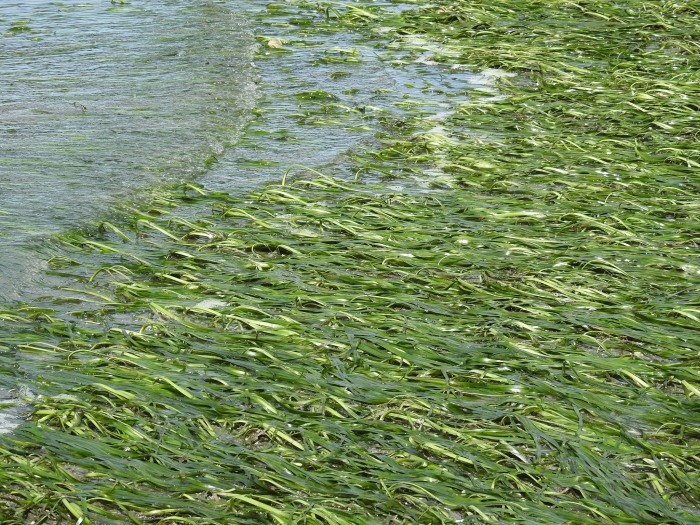Eelgrass
(Zostera marina)
Eelgrass (Zostera marina)
/
/

Steve Tuckerman
CC BY-SA 4.0
Image By:
Steve Tuckerman
Recorded By:
Copyright:
CC BY-SA 4.0
Copyright Notice:
Photo by: Steve Tuckerman | License Type: CC BY-SA 4.0 | License URL: http://creativecommons.org/licenses/by-sa/4.0/ | Rights Holder: Steve Tuckerman | Publisher: iNaturalist | Date Created: 2016-05-08T13:13:16-07:00 |
























Estimated Native Range
Summary
Zostera marina, commonly known as eelgrass, is a marine angiosperm native to shallow coastal waters, including bays, lagoons, and estuaries along the northern coastlines of North America and Eurasia. It is a key species in subtidal marine ecosystems, often forming extensive underwater meadows. Eelgrass anchors in sandy or muddy substrates via rhizomes and has long, ribbon-like, bright green leaves that can grow over 3 feet in length and up to 0.4 inches wide. It is a monoecious plant, meaning each individual bears both male and female flowers, which are inconspicuous and located in the leaf sheaths. The flowering season is generally in the summer.
Eelgrass is ecologically significant, providing critical habitat for a variety of marine organisms, including commercially important fish species like Pacific herring and juvenile Atlantic cod. It stabilizes sediment, helps maintain water clarity, and can sequester carbon, mitigating climate change effects. While not commonly cultivated, it is sometimes used in marine restoration projects. Eelgrass requires clear, relatively calm waters and is sensitive to disturbances such as dredging and pollution. It faces threats from invasive species, such as the algae Zostera japonica, and increased water turbidity, which can reduce light penetration necessary for photosynthesis. Conservation efforts include habitat protection and the development of restoration techniques to mitigate the impact of human activities.CC BY-SA 4.0
Eelgrass is ecologically significant, providing critical habitat for a variety of marine organisms, including commercially important fish species like Pacific herring and juvenile Atlantic cod. It stabilizes sediment, helps maintain water clarity, and can sequester carbon, mitigating climate change effects. While not commonly cultivated, it is sometimes used in marine restoration projects. Eelgrass requires clear, relatively calm waters and is sensitive to disturbances such as dredging and pollution. It faces threats from invasive species, such as the algae Zostera japonica, and increased water turbidity, which can reduce light penetration necessary for photosynthesis. Conservation efforts include habitat protection and the development of restoration techniques to mitigate the impact of human activities.CC BY-SA 4.0
Plant Description
- Plant Type: Herb
- Height: 2-9 feet
- Width: 1-3 feet
- Growth Rate: Moderate
- Flower Color: Green, White
- Flowering Season: Spring, Summer, Fall
- Leaf Retention: Evergreen
Growth Requirements
- Sun: Full Sun
- Water: Aquatic
- Drainage: Standing
Common Uses
Erosion Control, Low Maintenance, Water Garden
Natural Habitat
Shallow coastal waters, including bays, lagoons, and estuaries along the northern coastlines of North America and Eurasia, often forming extensive underwater meadows
Other Names
Common Names: Eelgrass, Common Eelgrass, Marrål, Marine Eelgrass
Scientific Names: , Zostera marina, Alga marina, Zostera hagstromii, Zostera latifolia, Zostera marina f. latifolia, Zostera marina f. sulcatifolia, Zostera marina f. typica, Zostera marina subsp. marina, Zostera marina var. atam
GBIF Accepted Name: